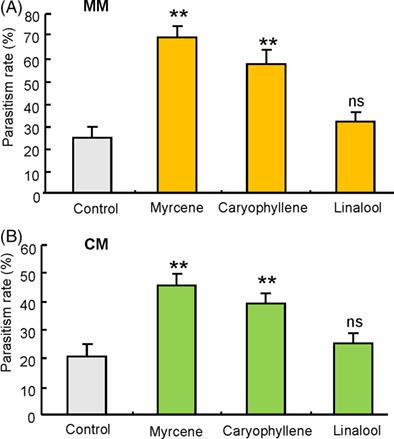当前位置:
X-MOL 学术
›
Pest Manag. Sci.
›
论文详情
Our official English website, www.x-mol.net, welcomes your
feedback! (Note: you will need to create a separate account there.)
Whitefly-induced tomato volatiles mediate host habitat location of the parasitic wasp Encarsia formosa, and enhance its efficacy as a bio-control agent.
Pest Management Science ( IF 3.8 ) Pub Date : 2020-09-05 , DOI: 10.1002/ps.6071 Chan-Shan Chen 1 , Chan Zhao 1 , Zhi-Yi Wu 2 , Guang-Fu Liu 1 , Xiao-Ping Yu 1 , Peng-Jun Zhang 1
Pest Management Science ( IF 3.8 ) Pub Date : 2020-09-05 , DOI: 10.1002/ps.6071 Chan-Shan Chen 1 , Chan Zhao 1 , Zhi-Yi Wu 2 , Guang-Fu Liu 1 , Xiao-Ping Yu 1 , Peng-Jun Zhang 1
Affiliation

|
Whitefly Bemisia tabaci is a phloem‐feeding insect and causes extensive agricultural damage around the world. Although the parasitic wasp Encarsia formosa is widely used to control B. tabaci on glasshouse tomatoes, low efficiency and discontinuity are frequently recorded. It has been well‐documented that herbivore‐induced plant volatiles (HIPVs) are important cues in the foraging behavior of the natural enemies of herbivores. However, the volatiles emitted from tomatoes infested by different developmental stages of B. tabaci (nymphs versus adults) have not been compared in terms of their effects on E. formosa attraction.
中文翻译:

烟粉虱诱导的番茄挥发物介导了寄生黄蜂恩卡西亚虫的寄主生境,并增强了其作为生物防治剂的功效。
烟粉虱烟粉虱是一种韧皮部食性昆虫,在世界范围内造成广泛的农业破坏。尽管寄生黄蜂(Encarsia formosa)被广泛用于控制温室番茄上的烟粉虱,但经常记录到其低效率和不连续性。已有充分的文献证明,草食动物引起的植物挥发物(HIPV)是草食动物天敌觅食行为的重要线索。但是,尚未比较番茄在烟粉虱不同发育阶段(若虫对成虫)侵染时所散发的挥发物对福美E吸引力的影响。
更新日期:2020-09-05
中文翻译:

烟粉虱诱导的番茄挥发物介导了寄生黄蜂恩卡西亚虫的寄主生境,并增强了其作为生物防治剂的功效。
烟粉虱烟粉虱是一种韧皮部食性昆虫,在世界范围内造成广泛的农业破坏。尽管寄生黄蜂(Encarsia formosa)被广泛用于控制温室番茄上的烟粉虱,但经常记录到其低效率和不连续性。已有充分的文献证明,草食动物引起的植物挥发物(HIPV)是草食动物天敌觅食行为的重要线索。但是,尚未比较番茄在烟粉虱不同发育阶段(若虫对成虫)侵染时所散发的挥发物对福美E吸引力的影响。











































 京公网安备 11010802027423号
京公网安备 11010802027423号